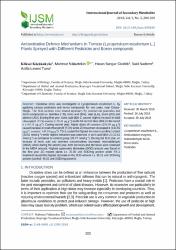Antioxidative Defence Mechanisms in Tomato (Lycopersicum esculentum L.) Plants Sprayed with Different Pesticides and Boron compounds
Özet
Oxidative stress was investigated in Lycopersicum esculentum L. by applying various pesticides and boron compounds for two years, near OrtacaMuğla. The field sections were treated separately by commercial pesticides and boron compounds i.e. tarimbor (TB), boric acid (BA), laser (LA), zoom (ZO) and admiral (AD). During first year, boric acid (BA-1) caused highest increase in total chlorophyll (TCh) content (158.41 ?g g-1 ) while the second dose (BA-2) decreased it (103.11 ?g g-1 ). During second year, higher doses of tarimbor (236.49 ?g g-1 ) caused increase in total chlorophyll (TCh) while ZO treatment decreased it (142.55 ?g g-1 ) (control: 149.55 ?g g-1 ). TB-1 caused the highest increase in proline content (33.52 nmol g-1 ) while highest reduction was observed in boric acid (BA-2) (22.51 nmol g-1 ) as compared to control group (26.77 nmol g-1 ). During the first year, an increase of boric acid and tarimbor concentrations decreased malonaldehyde (MDA) while during the second year, both increases and decreases were observed in the MDA amount. Highest superoxide dismutase (SOD) amount was found in the first year ZO treated plants i.e. 70.35 unit SOD/mg protein while TB-1 treatment caused the highest decrease in the SOD amount i.e. 35.21 unit SOD/mg protein (control: 45.23 unit SOD/mg protein).
Kaynak
International Journal of Secondary MetaboliteCilt
5Sayı
3Bağlantı
https://doi.org/10.21448/ijsm.450830https://app.trdizin.gov.tr//makale/TWpreU5USXdNQT09
https://hdl.handle.net/20.500.12809/8299


















